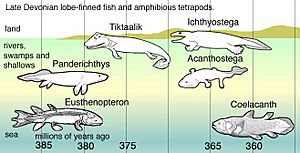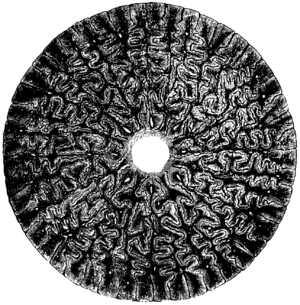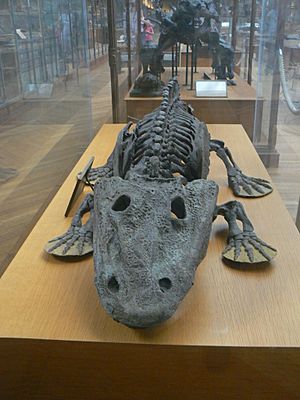Labyrinthodont facts for kids
Labyrinthodont is a name used for some very old, fossil amphibians. Even though scientists don't use this name in formal taxonomy (the way they classify living things) anymore, it's still helpful to talk about a group of animals that looked quite similar.
The name Labyrinthodont comes from two words: Labyrinth which means a maze, and dont which means tooth. This name describes the cool, maze-like pattern inside their teeth. These ancient creatures also had very strong, armored skulls, which is why they sometimes had an even older name: "Stegocephalia," meaning "armored heads."
Labyrinthodonts were some of the most important animals on Earth from the Devonian period to the early Triassic period. That's about 390 to 210 million years ago!
Contents
Special Features of Labyrinthodonts
Labyrinthodonts lived for over 200 million years. While they changed a lot over that time, their fossils have some clear features that make them easy to spot:
- Maze-like teeth: If you cut a labyrinthodont tooth in half, the inside looks like a complex labyrinth or maze. This pattern comes from the way the dentine and enamel of the tooth fold in on themselves.
- Strong, flat skull: They had a very thick, armored skull roof. The only openings were for their nostrils, eyes, and sometimes a "third eye" on top of their head. This flat, heavy skull is why they were also called "Stegocephalia." Later animals, like amniotes (reptiles and mammals), developed deeper skulls.
- Otic notch: This was a special notch or gap behind each eye at the back edge of their skull. In early water-dwelling forms, it might have been an open hole for breathing, like a spiracle. In some later forms, it might have held an ear-drum, helping them hear.
- Complex spine bones: Their vertebrae (the bones that make up their spine) were quite complicated, often made of four separate pieces.
Who Belongs to This Group?
Scientists used to group many different ancient amphibians under the term Labyrinthodonts. Today, they use more specific names, but here are some of the main groups that were once called Labyrinthodonts:
- Temnospondyls: These were a large and diverse group. Some scientists think modern amphibians (like frogs and salamanders) might have evolved from them.
- Lepospondyls: This was another group of ancient amphibians, also considered possible ancestors of modern amphibians.
- Reptiliomorphs: These were a group of animals that were very close to the ancestors of reptiles. They are now often placed in the group that includes all amniotes.
It's important to know that modern amphibians (Lissamphibians) and amniotes (animals that lay eggs on land, like reptiles and mammals) are not considered Labyrinthodonts.
Fishapods: The First Steps on Land

Early tetrapods (animals with four limbs) are now classified as a type of lobe-finned fish (Sarcopterygii). This is because we now know that their limbs first evolved while they were still living mostly in water.
The informal term fishapods is often used for this interesting group of Devonian animals that show the transition from fish to land-dwelling creatures. A more formal scientific term for them is "stem-group tetrapods." These animals are crucial for understanding how life moved from water to land.
Images for kids
-
Skeletal reconstruction of Acanthostega, an early (ichthyostegalian) labyrinthodont
-
Reconstruction of Branchiosaurus, a temnospondyl tadpole or paedomorph form with external gills
-
Acanthostega, a fish-like early ichthyostegalian
-
Seymouria, a terrestrial reptiliomorph from the Permian
-
Platyoposaurus, an advanced crocodile-like temnospondyl from the Permian
-
Eryops, a well known euskelian temnospondyl
-
Hyloplesion, a salamander-like lepospondyl
-
Tiktaalik, a transitional form between tetrapodomorph fish and labyrinthodonts, combining fishlike fins with a pectoral girdle separate from the skull
-
Pederpes, a six-fingered labyrinthodont from the fossil-poor Romer's gap
-
The waterways of coal forests, the typical primal hunting grounds of Carboniferous labyrinthodonts
-
The amphibamid temnospondyl Gerobatrachus from the Permian, proposed ancestor of lissamphibians
-
Classical 19th century interpretation of stegocephalians from the Crystal Palace, based on anuran amphibians
See also
 In Spanish: Laberintodonto para niños
In Spanish: Laberintodonto para niños
















